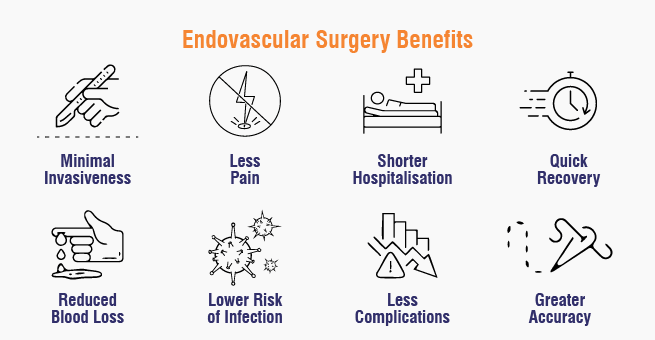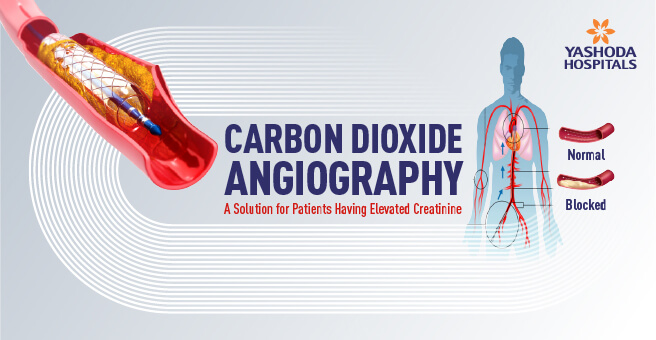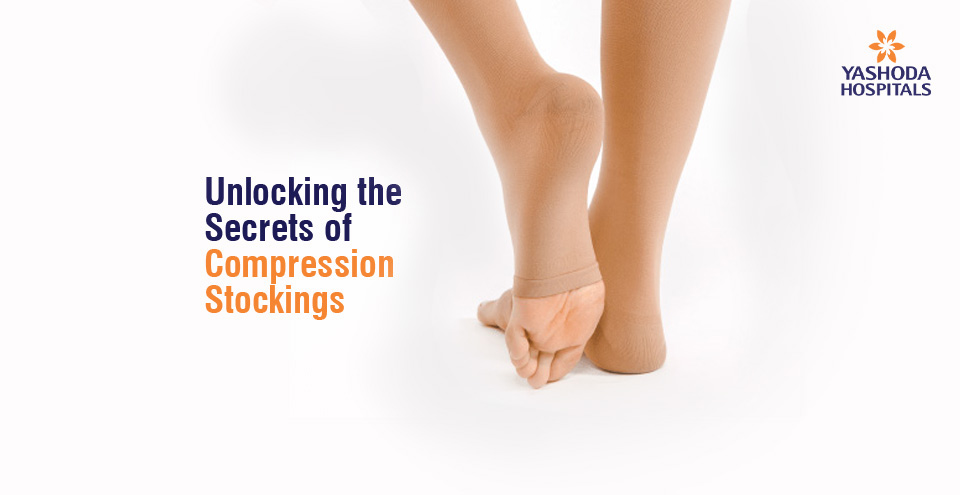Endovascular Surgery: Minimally Invasive Solution to Vascular Disease

Endovascular surgery is a revolutionary advancement in medical technology wherein doctors can treat almost any vascular condition at the most minimally invasive level possible. Unlike traditional open surgery, where large incisions are required, the procedures of endovascular surgery require small punctures in the skin to access blood vessels.
What is Endovascular Surgery?
Endovascular surgery is a minimally invasive approach to treating blood vessel conditions, unlike traditional open surgery. It uses catheters, thin, flexible tubes, inserted into blood vessels through small incisions.Advanced imaging techniques guide catheters, which can be positioned within blood vessels for therapeutic interventions like stents or aneurysm repair. Advantages offered by endovascular surgery as compared to traditional open surgery are smaller incisions, less pain, quicker recovery times, and fewer complications. This minimally invasive approach to surgery has significantly changed the vascular treatment of most conditions, opening up a shorter route to the recovery of a patient.
How Does Endovascular Surgery Work?
Endovascular surgery involves the following steps:
- Minimally Invasive Access: Surgeons use specialized catheters, like thin, flexible tubes, through the groin, arm, or wrist to access the blood vessels.
- Imaging Support: Image guidance includes the use of X-rays or ultrasounds to guide the catheters and to accurately place them in the blood vessels.
- Targeted Treatment: Upon reaching the effected site, the catheter may be used to administer a number of treatments, including:
- Stent Placement: A small, expandable mesh tube is inserted to widen narrowed blood vessels, like in angioplasty for coronary artery disease.
- Endovascular Aneurysm Repair: Placement of a stent graft to fortify a weakened area in the blood vessel wall, such as in Endovascular Aortic Aneurysm Repair (EVAR repair).
- Embolization: This technique is used to cut or block the blood flow to the abnormal blood vessels.
Explore Endovascular Treatment Options.
Types of Endovascular Surgery
The following provides a comprehensive overview of major types of endovascular surgery, with specific procedures and techniques varying based on individual patient and treatment condition:
- Angioplasty and Stenting
This is a common endovascular procedure where a balloon-tipped catheter is inserted into a narrowed artery, inflated to open it, and a stent, a mesh tube, is placed inside to maintain the artery’s openness. It is commonly used for conditions like coronary artery disease, PAD, and carotid artery stenosis.
-
- EVAR: The EVAR procedure treats aneurysms of the aorta, which is the main artery in the body. A stent graft is placed within the aneurysm to redirect blood flow away from the weakened area through this EVAR surgical procedure.
- Cerebral Aneurysm Coiling: Treats brain aneurysms by filling them with tiny metal coils to prevent rupture.
Embolization is a medical procedure that restricts blood flow to abnormal vessels, including those supplying tumors or malformations, and can also be used to treat certain types of uterine AV malformations.
- Venous Procedures
-
- Radiofrequency ablation or laser ablation: Varicose veins can be closed using these techniques.
- Catheter-Directed Thrombolysis (CDT): This procedure involves inserting a catheter into a blood clot vein and delivering thrombolytics directly to dissolve the clot; this is also referred to as endovascular therapy sometimes.
- Transarterial Radioembolization (TARE)
It is a procedure that uses radioactive beads to block the blood supply to liver tumors.
Benefits of Endovascular Surgery Over Open Surgery
Endovascular surgery offers several benefits, such as:
- Minimal Invasiveness: Smaller incisions cause less tissue trauma and faster healing.
- Less Pain: Less pain and discomfort than open surgery.
- Shorter Hospitalisation: Patients can be discharged sooner after the procedure.
- Faster Recovery: Most of the endovascular procedures are done under local anesthesia. Reduced recovery time allows patients to return to normal activities more quickly.
- Reduced Blood Loss: Less blood loss during the procedure and lower risk of blood transfusion.
- Lower Risk of Infection: Reduced incision sites minimize the infection risk at the surgical site.
- Better Cosmetic Outcomes: There is less scarring with small incisions.
- Reduced Complications: The chance of complications, such as heart attack and stroke, deep vein thrombosis, among others, is reduced.
- Improved Precision: There is better visualization of the area and targeted treatment with more advanced imaging.
- Improved Quality of Life: This is achieved through the faster recovery and decreased pain.

Indications of Endovascular Surgery
There are several conditions treated with endovascular surgery; some of the common indications include:
- Aneurysms: These are described as a ballooning or bulge in the wall of an artery. These weak areas are sensitive to rupture, resulting in possible internal bleeding and life-threatening consequences. Aneurysms can be present throughout the body. They may be found in the aorta, the largest artery in the human body, in the brain, and in the legs.
- Peripheral Artery Disease (PAD): This is a disorder of the blood vessels that deliver blood to your legs, arms, and elsewhere in your body. Plaque builds up within the arteries. This buildup restricts blood flow, causing pain, aching, cramping, numbness, or weakness in your legs. In its most severe forms, PAD may lead to tissue loss and even limb loss.
- Carotid Artery Disease: This is the narrowing of the carotid arteries, which supply blood to the brain. Plaque in these arteries can reduce blood flow to the brain, leading to stroke or transient ischemic attack (TIA).
- Varicose Veins: These are swollen, twisted veins, usually visible as blue or purple cords in the legs. They result from weakened valves within the veins that prevent blood from flowing properly back to the heart.
- Deep Vein Thrombosis (DVT): This disease is characterized by the formation of a blood clot in a deep vein, normally in the lower limbs. In some cases, DVT is a serious medical condition because a clot can become dislodged and travel to the lungs, causing pulmonary embolism.
Endovascular Surgery vs Open Vascular Surgery: A Brief Overview
Vascular surgery refers to a number of procedures performed for surgical repair of blood vessels, which include arteries, veins, and lymphatics. Traditionally, these procedures have been open surgery, requiring large incisions to access and repair the affected blood vessels. However, the advent of endovascular surgery has changed the game and offers a less invasive and often more efficient approach discussed in the above benefit section.
Endovascular surgery is a minimally invasive technique of treatment involving small incisions in the skin, usually on the groin or arm, with catheter-based access using thin, flexible tubes to reach the targeted area. Catheters are guided by advanced imaging techniques such as X-rays or ultrasound to deliver precise treatment.
The choice between endovascular and open surgery is determined by a variety of factors, including the specific condition, the patient’s overall health, and the surgeon’s expertise. In many cases, endovascular surgery offers significant advantages in terms of reduced invasiveness and faster recovery. However, in some complex cases, open surgery may be required.
The Future of Endovascular Surgery: A Journey Beyond the Spectrum
Endovascular surgery has transformed from therapy with a less invasive and efficient approach compared with traditional open surgery to more effective, less invasive alternatives. Still, the future ahead holds even greater promise.
Key Trends and Innovations
Advancements in Imaging and Navigation:
More-enhanced 3D imaging and added assistance via robotics will yet afford respite in precision and further reductions in complications. Real-time imaging allows surgeons to navigate much more easily through complex anatomy.
Building Biocompatible Materials:
There is ongoing research on biocompatible and biodegradable materials for stents and other implants to eliminate future complications and gain optimum results in patient’s outcomes.
Personalized Medicine:
It would include the development of tailored treatment under the special requirements of the patients based on their genetics-to-lifestyle adaptation in disease severities.
Less Invasive Interventions for Extremely Complex Pathologies:
Another active research and development area is widening the endovascular intervention spectrum for more complex entities, such as aortic dissection and complicated aneurysms.
Integrating Artificial Intelligence (AI) into regular practice:
AI algorithms will be useful in diagnosis, treatment planning, and even robotically assisted procedures, thereby increasing the accuracy and efficiency of endovascular treatment.
The future of endovascular surgery promises to evolve towards:
- Heightened safety and efficacy: Risks minimized and patient results maximized.
- Better patient experience: shorter hospital length, more rapid recovery, and less pain.
- Expanded treatment options: A broader variety of vascular conditions can be treated with minimally invasive approaches. While the future continues to face some challenges, it promises much.
Conclusion
Endovascular surgery has transformed the treatment of vascular diseases. It has given patients less invasive and more efficient treatment options. The endovascular procedures have improved the lives of many people by reducing invasiveness and accelerating recovery.
Yashoda Hospitals is a top health care service provider, and it’s known for the high level of advanced vascular care. The staff has experienced vascular & endovascular surgeons who employ the latest techniques and technologies in endovascular surgery, so they can treat all patients using state-of-the-art treatments, from aneurysms and peripheral artery disease to varicose veins, DVT, and pulmonary embolism.
Have any questions or concerns about your health? We’re here to help! Call us at 918065906165 for expert advice and support.
About Author –












 Appointment
Appointment WhatsApp
WhatsApp Call
Call More
More